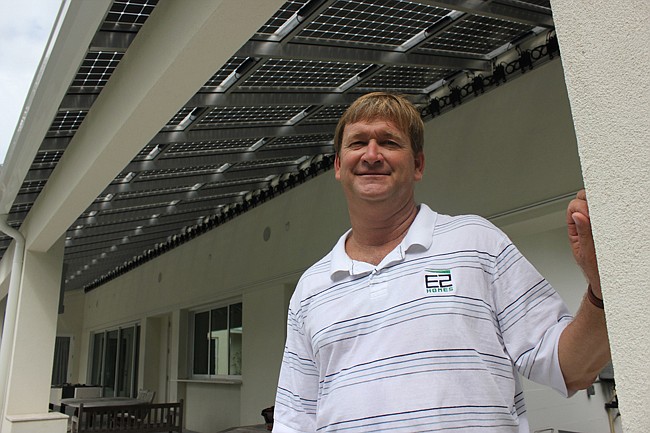- July 26, 2024
-
-
Loading

Loading

Many days, especially in the mild Florida spring and winter, when the sun is shining and there’s not a cloud in the sky, and windows are opened wide to let in the breeze, the electricity meter at the Wilson family’s home ticks backward.
The kilowatts flow out of their home instead of in from the power company. Each flux of digits on the meter represents the ding of a credit on their bill. This past spring, the Wilsons paid just 25 cents for their electricity, water and sewage consumption.
The Winter Park family owns a “net-zero” home, meaning they have a renewable energy system that on average creates more power than the home uses. Every month that happens, they receive a credit on their utility bill to use toward the next month. Instead of a roof on their patio, their home has a solar panel system that absorbs sunlight from both sides, generating power to operate their air conditioning, appliances, everything.
Right now, the Wilson home is one of only six in Winter Park with a renewable energy system hooked up to the city grid. Solar panels are a big up-front investment, with an average three bedroom home with a monthly utility bill of $200 needing a system costing about $30,000 to power it, according to solar power-selling website solarcity.com. Government rebates and tax credits can drop the cost by nearly half, but cost may still be prohibitive for many homeowners looking to go green.
“It’s more of a feel good investment,” said Rob Smith, founder of Winter Park based e2 Homes, the green residential construction firm that helped build the Wilson home. “I think there are some non-quantifiable benefits.”
A smaller carbon footprint is one of them, said homeowner Rebekkah Wilson.
“It’s important for people to consider it because even though each of us is a small piece of the bigger picture, the more small people that go toward alternative energy sources, the more of an impact we can have on preserving the resources we use,” she said.
In addition to the solar panels, the home is energy-efficient and sustainable. There’s a cistern that provides water for irrigation and toilets, no grass to water, and recycled wood floors. There are windows up high to draw out hot air and give light to reduce lamp use. It was made for warm, sunny days.
“I don’t think they build houses now that take advantage of our environment,” said homeowner Rick Wilson. “I was passionate about what I wanted and what I think Florida living should be.”
Rick said his motivation for building his green house was to save money, and he’ll recoup his solar panel cost through electricity bill savings in about eight years.
It’s a long-view investment, but one that Tim Maslow, the city of Winter Park’s sustainability coordinator, said will increase in popularity as the cost of solar panels decreases. The price has gone down by nearly half in the past five years, and financing programs for incorporating solar costs into mortgages have made it more affordable for homeowners, Smith said.
Jerry Warren, director of Electric Utility for the city of Winter Park, has even been negotiating a solar panel project to produce energy for the city that he hopes will be approved early next year. There’s a proposed contract to buy solar power produced by rooftop panels put on the city’s public works facility from solar company Clean Footprint for 10 years at a rate of 6.5 cents per kilowatt-hour. That’s almost the same price as natural gas, which is about 6 cents, but without the harmful greenhouse gases. Warren, who’s been in the power business for 40 years, said he sees a future in solar energy.
“That’s almost down to the point where it’s cost competitive with more traditional sources of power,” he said. “And so, my take is that the reduction in cost of solar is going to make it very competitive over the next 25 years, and the way we make it very competitive as an industry is we begin to incorporate it into our power supply mix in small enough blocks that it doesn’t adversely affect our overall cost of power.”
“This would get us on the map for renewables,” Maslow said.
Until then, the number of alternative energy pioneers in Winter Park will continue to grow slowly, Warren said, with more residents using the sun to their advantage, rather than fighting it.